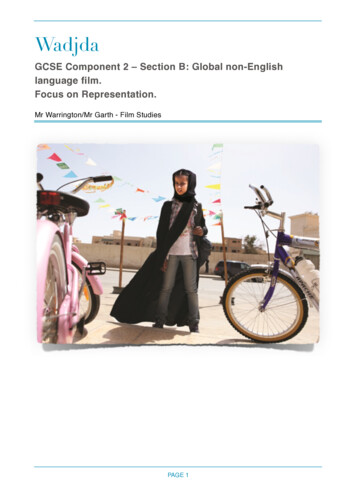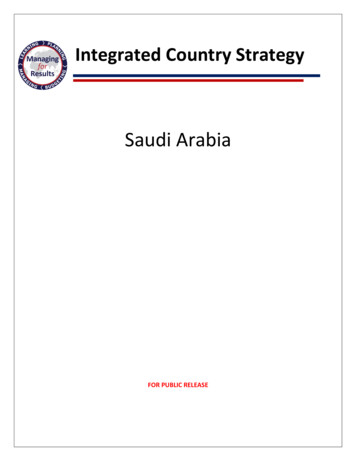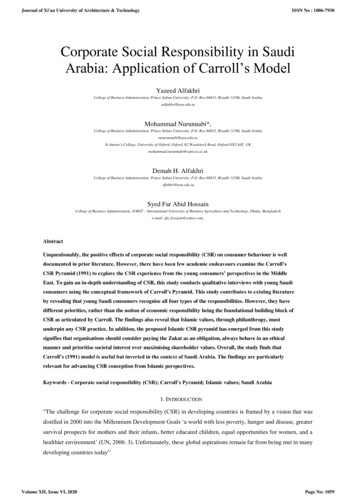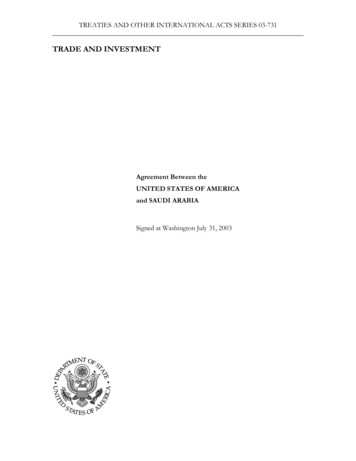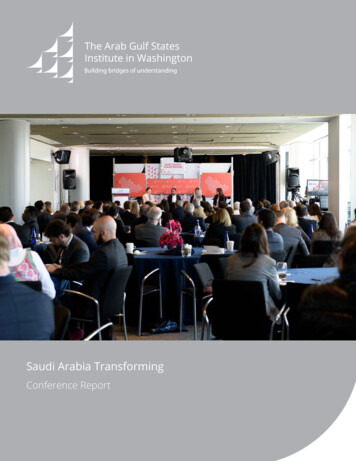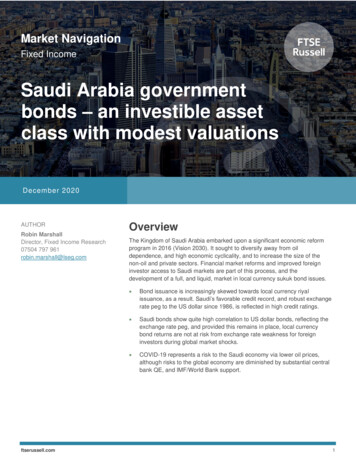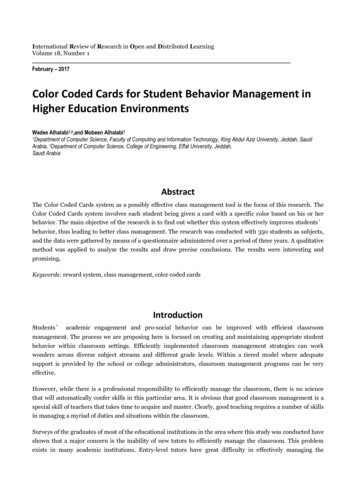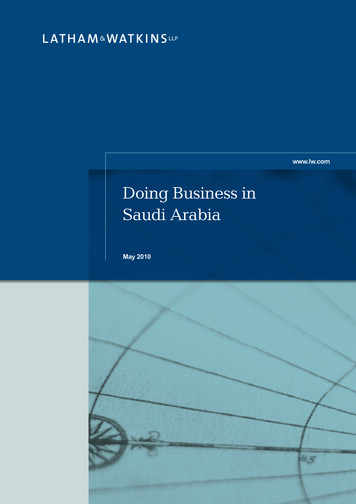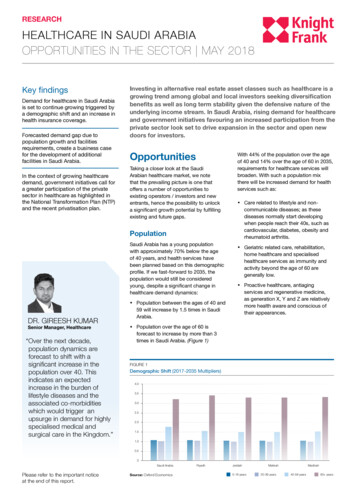
Transcription
RESEARCHHEALTHCARE IN SAUDI ARABIAOPPORTUNITIES IN THE SECTOR MAY 2018Key findingsDemand for healthcare in Saudi Arabiais set to continue growing triggered bya demographic shift and an increase inhealth insurance coverage.Forecasted demand gap due topopulation growth and facilitiesrequirements, create a business casefor the development of additionalfacilities in Saudi Arabia.In the context of growing healthcaredemand, government initiatives call fora greater participation of the privatesector in healthcare as highlighted inthe National Transformation Plan (NTP)and the recent privatisation plan.Investing in alternative real estate asset classes such as healthcare is agrowing trend among global and local investors seeking diversificationbenefits as well as long term stability given the defensive nature of theunderlying income stream. In Saudi Arabia, rising demand for healthcareand government initiatives favouring an increased participation from theprivate sector look set to drive expansion in the sector and open newdoors for investors.OpportunitiesTaking a closer look at the SaudiArabian healthcare market, we notethat the prevailing picture is one thatoffers a number of opportunities toexisting operators / investors and newentrants, hence the possibility to unlocka significant growth potential by fulfillingexisting and future gaps.With 44% of the population over the ageof 40 and 14% over the age of 60 in 2035,requirements for healthcare services willbroaden. With such a population mixthere will be increased demand for healthservices such as: Care related to lifestyle and noncommunicable diseases; as thesediseases normally start developingwhen people reach their 40s, such ascardiovascular, diabetes, obesity andrheumatoid arthritis. Geriatric related care, rehabilitation,home healthcare and specialisedhealthcare services as immunity andactivity beyond the age of 60 aregenerally low. Proactive healthcare, antiagingservices and regenerative medicine,as generation X, Y and Z are relativelymore health aware and conscious oftheir appearances.PopulationSaudi Arabia has a young populationwith approximately 70% below the ageof 40 years, and health services havebeen planned based on this demographicprofile. If we fast-forward to 2035, thepopulation would still be consideredyoung, despite a significant change inhealthcare demand dynamics:DR. GIREESH KUMARSenior Manager, Healthcare“Over the next decade,population dynamics areforecast to shift with asignificant increase in thepopulation over 40. Thisindicates an expectedincrease in the burden oflifestyle diseases and theassociated co-morbiditieswhich would trigger anupsurge in demand for highlyspecialised medical andsurgical care in the Kingdom.” Population between the ages of 40 and59 will increase by 1.5 times in SaudiArabia. Population over the age of 60 isforecast to increase by more than 3times in Saudi Arabia. (Figure 1)FIGURE 1Demographic Shift (2017-2035 Multipliers)4.03.53.02.52.01.51.00.50Saudi ArabiaPlease refer to the important noticeat the end of this report.Source: Oxford EconomicsRiyadhJeddah0-19 yearsMakkah20-39 yearsMadinah40-59 years60 years
HEALTHCARE IN SAUDI ARABIA OPPORTUNITIES IN THE SECTORHealthcare facilitiesrequirements, these cities shouldstrongly consider the introduction ofmedical tourism to complement theirreligious tourism. Over the last tenyears, the number of Hajj pilgrimsremained within the region of 1.9million to 3.2 million, while Umrahpilgrims peaked in 2017 at 8.4 million.Assuming adequate infrastructureis in place, these cities are uniquelypositioned to cater to the spiritualand medical requirements of thepopulation. This would appeal toa significant number of Muslimswho would consider benefiting fromspirituality and holiness of these citieswhilst being treated.Healthcare facilities in the Holy andeconomic cities are lower than thenational average and significantlylower than the global average. Thesefacts create a business case for theestablishment of healthcare facilities.(Figure 2) Economic cities – these citiesgenerally have better healthcareinfrastructure than the rest of thecountry and host patients from theother parts of the Kingdom. Lowerinfrastructure density and the existingstrain on healthcare resources presentsopportunities for additional beds,centres of excellences, specialised andniche healthcare services commonlyfound in developed metropolises.Careful study of specialisationopportunities and their subsequentintroduction will help improveavailability of healthcare in the country,curb outbound medical tourism andsave outflows from the exchequer.Holy cities – private healthcarefacilities in these cities can beclassified as basic with potential forupgrade. With the relaxation of visaForecasted demand To keep pace with population growth,Saudi Arabia would require anadditional 5,000 beds by 2020 and20,000 beds by 2035, based on thecurrent density of beds. Based on the global average of beddensity, Saudi Arabia was faced witha gap of 14,000 beds in 2016 and thisgap is expected to widen to 40,000beds by 2035. (Figure 3)FIGURE 2Beds per 1,000 populationNumber of .50RAYA MAJDALANIResearch Manager“The current situationpresents a need as wellas an opportunity for thedevelopment of privatehealthcare in Saudi Arabia.The private sector cancount on the right enablingenvironment to drive itsparticipation in healthcare.”Global averageSaudi ArabiaRiyadhMadinahSource: Ministry of HealthFIGURE 3Estimated demand 2020 - 2035Number of 005,00002020Source: Knight Frank Research2025Beds required based on currentdensity (base year 2016)20302035Beds required based on global average(base year 2016)
HEALTHCARE IN SAUDI ARABIA OPPORTUNITIES IN THE SECTORGovernmentinitiativesMandatory Health InsuranceThe roll-out of the Mandatory HealthInsurance (MHI) to private sectoremployees in Saudi Arabia took placein various stages. We outline thesedevelopments in Figure 4 below.Several government-driven initiatives arechanging the dynamics of the sector andcontributing in reshaping the healthcarelandscape in the Kingdom by creating astronger institutional set-up and effectiveregulatory frameworks to promote privatesector investment in healthcare.FIGURE 4Mandatory private health insurance program, key milestones to dateEarly 2000’s: First initiatives toshift funding of healthcare fromthe government to the privatesector with the introduction of theMandatory Health Insurance (MHI)program.20002005: Completion of the first majormilestone of the MHI programwhich brought all expats workingin the private sector under healthinsurance coverage.20052016-2017: Implementation of theUnified Health Insurance policy instages depending on the size ofthe company.20162002: Formation of the HealthInsurance Council responsiblefor guiding the introduction of theMandatory Health Insurance (MHI).Phase 1: Starting July 2016 targeted companies with morethan 100 employees.Phase 2: Starting October 2016 targeted companies between 50and 99 employees.Phase 3: Starting January 2017 targeted companies between 25and 49 employees.Phase 4: Starting April 2017 targeted companies with less than25 employees.Following the implementationof Phase 4, all privatesector employees and theirdependents were brought underthe insurance coverage.2018: The Cooperative Councilof Health Insurance (CCHI)expanded the coverage of theunified health insurance policy toinclude additional benefits thatshall apply to new and renewedpolicies starting July 2018.Source: Knight Frank Research2018PresentPresent: 27 insurance companiesare operating in Saudi Arabia withmore than 11 million beneficiariesincluding Saudi nationals andexpatriates.
HEALTHCARE IN SAUDI ARABIA OPPORTUNITIES IN THE SECTORSaudi Vision 2030and the NTPHealthcare is one of the main focusareas of the Vision 2030 and the NationalTransformation Plan (NTP).The main goal of the Saudi Vision 2030is to diversify the economy away fromhydrocarbons and trigger a greaterparticipation of the private sector byencouraging both local and internationalinvestments in a number of key sectors,one of which is healthcare. Privatisationof government services is expected tohelp meet the goals set out in Vision 2030with the aim to increase private sector’scontribution to GDP from 40% to 65% in2030.The NTP, which was developed to helpfulfil the Saudi Vision 2030, has identifiednumber of key targets to be met by eachgovernment body by 2020. The Kingdom’shealthcare plan under the NTP hasplaced the sector on a fast trajectory toprivatisation and growth over the comingyears. Targets set out by the NTP forthe Ministry of Health for the year 2020include:SHEHZAD JAMALPartner“Healthcare is undergoing atransformation phase – longterm view and thoroughresearch must to be takenwhile investing in the sectorto ensure investmentsmatch current andforecasted demand.” Increasing private healthcareexpenditure from 25% to 35% of totalhealthcare expenditure. Increasing the number of licensedmedical facilities from 40 to 100. Increasing the number of internationallyaccredited hospitals. Doubling the number of primaryhealthcare visits per capita from twoto four. Decreasing the percentage of smokingand obesity incidence by 2% and 1%from baseline respectively. Doubling the percentage of patientswho receive healthcare after criticalcare and long-term hospitalisationwithin 4 weeks from 25% to 50%. Focusing on improving the quality ofpreventive and therapeutic healthcareservices. Increasing focus on digital healthcareinnovations.In parallel with a shift towards a greaterparticipation of the private sector,healthcare is expected to remain a keyarea of government spending in thistransition phase.The allocated budget for healthcare underthe NTP stands at SAR 23 billion, of thetotal SAR 268 billion (over 5 years ending2020) which is the fourth largest area ofspending under the NTP. We see this asan encouraging step for the sector amidstthe ongoing transformation.From a public finance perspective,healthcare remains the third largest areaof government spending following militaryand education, accounting for 15% oftotal expenditures in the 2018 announcedbudget.Privatisation and PPPschemesPrivatisation is seen as a key focus area inthe Saudi Vision 2030 and the NTP. Thestrategic objectives stated for healthcarein the NTP include: Privatisation of one of the medicalcities through a Public-PrivatePartnership (PPP) scheme. Increasing private sector share ofspending in healthcare throughalternative financing methods andservice providers.In April 2018, Saudi Arabia announcedan ambitious privatisation plan, whichincludes 14 PPP investments to becompleted across 10 sectors includinghealthcare by 2020. The key targets of theprivatisation plan in relation to healthcareinclude: Updating and expanding primary careacross Saudi Arabia. Providing additional rehabilitationand long-term care beds across theKingdom through the creation of PPPstructures. Planning for the establishment ofadditional medical cities. Preparing King Faisal SpecialistHospital & Research Center forprivatisation and help it in achieving itsleadership position through focusingon innovation. Updating and expanding laboratoryand radiology services across thecountry in partnership with the privatesector.The most significant constraint to thedevelopment of the PPP market in SaudiArabia is the absence of a clear legal
HEALTHCARE IN SAUDI ARABIA OPPORTUNITIES IN THE SECTORframework for investors. In February 2018,Custodian of the Two Holy Mosques KingSalman approved a number of decisionstaken by the Saudi Health Councilincluding the establishment of a PPPprogram in the healthcare sector.Value perspective— healthcare realestateFigures 6 & 7 present the investment andpotential returns that can be generatedfrom healthcare assets. The data on builtup-area (BUA) and construction costsare sourced from industry averages andcan vary due to the type of offering andspeciality. The yield sits on a range basedon risk profile, which increase or decreasebased on the factors mentioned below:In the short to medium term, based on thefactors mentioned above, the healthcarespace in Saudi Arabia presents itself as asector with high growth opportunities. Toensure long-term success it is importantto carefully study the market, identify gapsand be willing to continuously embracetechnological advancement.Private investment in healthcare is beingguided by the Saudi Arabian GeneralInvestment Authority (SAGIA) and wecan expect to see further changes toregulatory controls in order to achievethe goal of increased private sectorinvolvement and investment whileensuring a suitable regulatory frameworkfor the upcoming privatisation waves andPPP schemes within the healthcare sector.FIGURE 6Real estate value perspective,50 hospital bedsLowHighBUA in sq m5,0008,750Construction costwith fixed fit out(SAR / sq m)6,0008,500Source: Knight Frank ResearchFIGURE 7Initial yield rangeAge of the assetLength of the lease tenure11%HighCovenant strength and security10%Position of the operations on thebusiness life cycleHigh risk Conclusion9%8%FIGURE 5Low7%6%5%Source: Knight Frank ResearchInternational healthcare service providersto directly enter the Saudi Arabianhealthcare market.Private healthcare sector to benefit fromincreased patient volume and improvedspending power.Increased demand for primary caredue to its enhanced role.Collaboration with internationaloperators for digital healthcare solutions(telemedicine).Attracting long-term care providers to thesector which includes inpatient and homehealthcare services.Source: Knight Frank ResearchCreating opportunities for preventive andregenerative medicine.Low riskGovernment initiatives and plans, resulting opportunities
KINGDOM OF SAUDI ARABIAStefan Burch, MRICSGeneral Manager & Partner 966 53 0893 297stefan.burch@me.knightfrank.comEDUCATION & HEALTHCAREShehzad JamalPartner 971 56 4101 298shehzad.jamal@me.knightfrank.comDr. Gireesh KumarSenior Manager, Healthcare 971 56 4845 490gireesh.kumar@me.knightfrank.comRESEARCHRaya MajdalaniResearch Manager 971 56 4206 735raya.majdalani@me.knightfrank.comDEVELOPMENT CONSULTANCY &RESEARCHHarmen De JongPartner 971 56 1766 588harmen.dejong@me.knightfrank.comVALUATION & ADVISORY SERVICESStephen Flanagan, MRICSPartner 971 50 8133 402stephen.flanagan@me.knightfrank.comCAPITAL MARKETS / INVESTMENTRECENT MARKET-LEADING RESEARCH PUBLICATIONSJoseph Morris, MRICSPartner 971 50 5036 351joseph.morris@me.knightfrank.comMEDIA & MARKETINGNicola MiltonHead of Middle East Marketing 971 56 6116 368nicola.milton@me.knightfrank.comKSA Capital MarketIndicators April 2018KSA ValuationsNewsletter Q2 2018REITS Insights onSaudi Arabia Q1 2018KSA Residential MarketReview 2018Important NoticeREITs Insights onSaudi Arabia Q3 2017Riyadh & JeddahHospitality Winter 2017Global Cities 2018New FrontiersKnight Frank Research Reports are available at KnightFrank.com/ResearchRegional offices in:Botswana Kenya Malawi Nigeria Rwanda Saudi Arabia South AfricaTanzania UAE Uganda Zambia Zimbabwe Knight Frank 2018 - This report is published forgeneral information only and not to be relied uponin any way. Although high standards have beenused in the preparation of the information, analysis,views and projections presented in this report, noresponsibility or liability whatsoever can be acceptedby Knight Frank for any loss or damage resultant fromany use of, reliance on or reference to the contentsof this document. As a general report, this materialdoes not necessarily represent the view of KnightFrank in relation to particular properties or projects.Reproduction of this report in whole or in part is notallowed without prior written approval of Knight Frankto the form and content within which it appears.Knight Frank Middle East Limited (Saudi ArabiaBranch) is a foreign branch registered in Saudi Arabiawith registration number 1010432042. Our registeredoffice is at Office No. 8, Building No. 1224, Street 298,King Abdul Aziz Road, Al Yasmin district, Riyadh,Kingdom of Saudi Arabia.
بحث تجاري المملكة العربية السعودية الفرص المتاحة في قطاع الرعاية الصحية مايو 2018 النتائج الرئيسية تشير التوقعات إلى أن الطلب على الرعاية الصحية في المملكة العربية السعودية سيواصل النمو بفضل التحول الديموغرافي والزيادة في تغطية التأمين الصحي . الفجوة المتوقعة في الطلب بسبب النمو السكاني والحاجة الى المزيد من المنشآت ، توفر ً حافزا للعمل على تطوير منشآت إضافية في جميع أنحاء المملكة العربية السعودية . ولتلبية الطلب المتزايد على الرعاية الصحية ، تدعو المبادرات والخطط الحكومية إلى مشاركة أكبر للقطاع الخاص في الرعاية الصحية كما هو موضح في خطة التحول الوطني ( )NTP وخطة الخصخصة الحديثة . ً ً متزايدا اتجاها يمثــل االســتثمار فــي فئــات األصــول العقاريــة البديلة مثــل الرعاية الصحيــة بيــن المســتثمرين العالمييــن والمحلييــن الذيــن ينشــدون فوائــد التنويع واألســتقرار على المــدى الطويــل بفضــل الطبيعــة الدفاعيــة لمــورد الدخل األساســي . في المملكــة العربية الســعودية ، مــن المتوقــع أن يــؤدي ارتفــاع الطلــب على الرعايــة الصحية والمبادرات الحكوميــة الداعيــة إلــى مشــاركة أكبــر للقطــاع الخــاص ، إلى مزيدٍ من التوســع في القطاع وفتــح أبواب جديدة للمســتثمرين . الفــرص المتاحة يمثــل االســتثمار فــي فئات األصــول البديلة مثل ً متزايدا بين المســتثمرين الرعايــة الصحيــة اتجاهـ ًـا العالمييــن والمحلييــن الذين ينشــدون مــا يحققه التنويــع مــن فوائد واســتقرار علــى المدى الطويل بفضــل الطبيعــة الدفاعيــة لمورد الدخل األساســي . مفصلة علــى قطاع الرعاية وعنــد إلقــاء نظــرة ّ الصحيــة فــي المملكــة العربية الســعودية ، نلحظ توفــر عــدد من الفــرص للمشغلين / المســتثمرين الحالييــن والوافديــن الجــدد في القطاع بما يشــير إلــى إمكانــات نمــو كبيــرة ترتبط بجهود ســد الثغرات الحالية والمســتقبلية . مــن المتوقــع أن يزيــد عدد الســكان فوق 60 ســنة بأكثــر مــن 3 أضعــاف في المملكــة العربية الســعودية ( . الشكل )1 ومــع وصول نســبة الســكان الذيــن تزيد أعمارهم عــن 40 ســنة إلــى 44% والذين تزيــد أعمارهم عن 60 ســنة إلى 14% عام ،2035 ســتكون هناك زيــادة فــي المتطلبــات المرتبطــة بخدمات الرعاية الصحيــة . وفــي ظل هذا المزيج الســكاني ، ســيرتفع الطلــب علــى الخدمــات الصحية مثل : الرعايــة المتعلقــة بنمــط الحياة واألمراض غيــر المعديــة؛ حيــث تبــدأ هذه األمراض عادةً في الظهور عندما يصل األشــخاص إلى ســن األربعيــن . وتعد أمــراض القلب واألوعية الدموية والســكري والســمنة والتهاب المفاصــل الروماتويــدي أمثلــة قليلــة على ذلك . السكان د . جيريش كومار مدير ّأول ، الرعاية الصحية “من المتوقع أن تتحول ديناميكيات السكان في العقد القادم ، مع زيادة كبيرة في عدد السكان الذين تزيد أعمارهم عن 40 سنة ، مما يعني زيادة في عبء أمراض نمط الحياة واألمراض المصاحبة المرتبطة بها . وقد يؤدي هذا بدوره إلى زيادة الطلب على الرعاية الطبية والجراحية عالية التخصص في المملكة ”. يمثــل الشــباب ممــن تقل أعمارهم عن 40 ســنة فــي المملكــة العربيــة الســعودية حوالي 70% من الســكان وقــد تــم تخطيط خدمات الرعايــة الصحية ـاء علــى هــذه الصــورة الديموغرافية . فإذا ما بنـ ً تقدمنــا بســرعة إلــى عــام ،2035 ال يزال باإلمكان اعتبــار الفئــة الســكانية الغالبــة من الشــباب ولكن ســتتغير ديناميــات الطلــب على الرعايــة الصحية بشــكل كبير : الرعايــة المتعلقــة بالمســنين وإعــادة التأهيل والرعايــة الصحيــة المنزليــة وخدمات الرعاية الصحيــة المتخصصــة حيــث تنخفــض المناعة والنشــاط بعد ســن الســتين بشكل عام . الرعايــة الصحيــة االســتباقية والخدمات المضــادة للشــيخوخة والطــب التجديدي حيث تكــون األجيــال X و Y و Z أكثــر وعيـ ًـا بالصحة وبالمظهر الشــخصي . ســيزداد عدد الســكان بين ســن 40 و 59 ســنة المرة ( )1.5 فــي المملكة بنســبة مـ ّـرة ونصــف ّ العربية الســعودية . الشكل 1 التحول الديموغرافي (أضعاف )2017 - 2035 4.0 3.5 3.0 2.5 2.0 1.5 1.0 0.5 0 المملكة العربية السعودية المصدر : مؤسسة أوكسفورد إيكونوميكس ُيرجى الرجوع إلى اإلشعار الهام في نهاية هذا التقرير . الرياض جدة مكة 0-19 المدينة 20-39 40-59 60
المملكة العربية السعودية الفرص المتاحة في قطاع الرعاية الصحية مرافق الرعايــة الصحية مرافــق الرعايــة الصحيــة في المدن المقدســة والمــدن االقتصاديــة أقــل من متوســط المملكة العربيــة الســعودية وأقــل بكثير من المتوســط ً حافزا إلنشــاء مرافق الرعاية العالمــي ممــا يشـ ّـكل الصحية ( . الشــكل )2 اﻟﻣدن اﻻﻗﺗﺻﺎدﯾﺔ - ﺗﺗﻣﺗﻊ ھــذه اﻟﻣدن ﺑﺻﻔﺔ ﻋﺎﻣﺔ ﺑﺑﻧﯾﺔ ﺗﺣﺗﯾﺔ أفضــل فــي قطاع الرعايــة الصحيــة مقارنـ ًـة ببقية اﻟﺑﻼد وتســتقبل المرضــى ﻣن اﻟﻣﻧﺎطق اﻷﺧرى يوفــر هــذا االنخفاض في ﻓﻲ اﻟﻣﻣﻟﮐﺔ ّ . كثافــة البنيــة التحتيــة والضغــط الحالي على ً األســرة مــوارد الرعايــة الصحية فرصا لزيادة ِّ ومراكــز االمتيــاز وخدمات الرعايــة الصحية المتخصصــة كمــا هو الحــال في العواصم المتقدمة . ومن شــأن الدراســة الدقيقة للتخصصــات وتوفيــر التخصصــات المطلوبة أن يســهم فــي تحســين توافر الرعايــة الصحية فــي البــاد والحد من الســياحة العالجية الخارجيــة وحفــظ التدفقــات الخارجــة من خزانة الدولة . المــدن المقدســة - يمكــن تصنيف مرافق الرعايــة الصحيــة الخاصــة في هذه المدن علــى أنهــا أساســية مع إمكانيــة تطويرها . ومع تخفيــف القيــود علــى منح التأشــيرات ، يجب علــى هــذه المــدن أن ّ بجدية في إدراج تفكــر ّ الســياحة الطبية الســتكمال الســياحة الدينية . فعلــى مــدى الســنوات العشــر الماضية ، بقي عــدد الحجــاج ضمن نطــاق 1,9 مليون إلى 3,2 مليــون فــي حيــن بلغ عــدد المعتمرين ذروتــه فــي عــام 2017 حيث وصل الى 8,4 مليــون . وعنــد إنشــاء بنيــة تحتية كافية ، ســتكون هــذه المــدن في وضع فريــد ّ يمكنها مــن تلبيــة االحتياجات الروحيــة والطبية للســكان . وهــذا مــن شــأنه بالتأكيد أن يجذب عـ ً ـددا أكبــر مــن المســلمين الذين قد تكون لهــم فرصة االســتفادة مــن الطابع الديني والعــاج فــي الوقت ذاتــه في هذه المدن . الطلــب المتوقع لمواكبــة النمــو الســكاني ، ســتحتاج المملكة العربية الســعودية إلى 5,000 ســرير إضافي بحلــول عام 2020 و 20,000 ســرير اضافي ً األســرة بناءا على نســبة بحلول عام 2035 ّ حالي ًا . المتوفــرة ّ ّ واسـ ً ـتنادا إلى المتوســط العالمي ، واجهت المملكــة العربيــة الســعودية فجوة قدرها توقع أن وي ً 14,000 ســرير في عام ُ 2016 تتســع لتصل إلى 40,000 ســرير بحلول عام ( .2035 الشــكل )3 الشكل 2 األس َرة لكل 1000 نسمة عدد ِّ األس َرة عدد ِّ 3.0 2.7 2.5 2.2 2.0 1.6 1.5 1.9 1.5 1.4 1.0 0.5 0 ريا مجدالني مديرة األبحاث “ينطوي الوضع الحالي على الحاجة إلى تطوير الرعاية الصحية الخاصة في المملكة وكذلك على فرصة يمكن اغتنامها . ويمكن للقطاع الخاص في المملكة العربية السعودية االعتماد على البيئة المناسبة لدفع مشاركته في قطاع الرعاية الصحية المتنامي ”. المتوسط العالمي الرياض المملكة العربية السعودية جدة المدينة مكة المصدر : وزارة الصحة الشكل 3 مستويات الطلب المقدرة 2020 – 2035 األس َرة عدد ِّ 45,000 40,000 35,000 30,000 25,000 20,000 15,000 10,000 5,000 0 2020 المصدر : أبحاث نايت فرانك 2025 2030 ً حالي ًا األسرة بناءا على نسبة األسرة المطلوبة - ّ عدد ِّ ّ المتوفرة ّ (عام األساس )2016 2035 ً بناءا على المتوسط العالمي األسرة المطلوبة - عدد ِّ (عام األساس )2016
المملكة العربية السعودية الفرص المتاحة في قطاع الرعاية الصحية المبــادرات والخطط الحكومية التأميــن الصحي اإللزامي كمــا هــو مبيــن بالخط الزمنــي أدناه ، تم إنفاذ التأميــن الصحــي اإللزامــي علــى الموظفين في القطــاع الخــاص بالمملكــة علــى عدة مراحل . (الشكل )4 تســتهدف العديــد مــن المبادرات الحكوميــة تغيير ديناميــات القطــاع والمســاهمة في إعادة تشــكيل قطــاع الرعايــة الصحيــة فــي المملكة من خالل إنشــاء هيــكل مؤسســي وإطــار تنظيمي أكثر قوة وفعاليــة لتعزيــز اســتثمار القطــاع الخاص في قطاع الرعايــة الصحية . الشكل 4 التأمين الصحي اإللزامي ، أبرز مراحل التطبيق مطلــع األلفيــة الثالثــة : المبادرات األولى لتحويــل تمويــل الرعايــة الصحية من الحكومــة إلــى القطــاع الخاص مع إدخال العمــل ببرنامــج التأميــن الصحي اإللزامي ( .)MHI 2000 :2002 تشــكيل مجلــس الضمــان الصحي المســؤول عــن توجيه إدخــال التأمين الصحــي اإللزامي . :2005 إتمــام المرحلــة الرئيســية األولى مــن برنامــج التأميــن الصحي اإللزامي الــذي أخضــع جميــع العمالة الوافدة في القطــاع الخــاص لتغطيــة التأمين الصحي . 2005 :2016-2017 تنفيــذ وثيقــة التأمين الموحدة على مراحل حســب حجم الشــركة . 2016 :2018 قــام مجلــس الضمان الصحي التعاونــي ( )CCHI بتوســيع نطــاق تغطية وثيقــة التأميــن الصحي الموحدة لتشــمل منافــع إضافيــة تنطبــق على الوثائق ـداء من يوليو الجديــدة ُ والمجــددة ابتـ ً .2018 2018 ـداء من يوليو - 2016 المرحلــة األولــى : ابتـ ً اســتهداف الشــركات التي يعمــل بها أكثر مــن 100 موظف . ـداء مــن أكتوبر - 2016 المرحلــة الثانيــة : ابتـ ً اســتهداف الشــركات التي يعمــل بها بين 50 و 99 موظفـ ًـا . ـداء مــن يناير - 2017 المرحلــة الثالثــة : ابتـ ً اســتهداف الشــركات التي يعمــل بها بين 25 و 49 موظفـ ًـا ـداء من أبريل - 2017 المرحلــة الرابعــة : ابتـ ً اســتهداف الشــركات التي يعمل بها 25 موظفـ ًـا أو أقل . بعــد تنفيــذ المرحلــة الرابعــة ، أصبح جميع ومعاليهم موظفــي القطاع الخــاص ُ خاضعيــن للتغطيــة التأمينية . Present المصدر : أبحاث نايت فرانك فــي الوقــت الحاضر 27 : شــركة تأمين تعمــل فــي المملكة العربية الســعودية تغطــي أكثــر مــن 11 مليون مســتفيد من المواطنيــن الســعوديين والمغتربيــن على حد سواء . ّ
المملكة العربية السعودية الفرص المتاحة في قطاع الرعاية الصحية رؤيــة المملكــة العربية الســعودية 2030 وخطــة التحــول الوطني تعــد الرعايــة الصحيــة واحدة من مجــاالت التركيز الرئيســية فــي رؤيــة 2030 وخطــة التحول الوطني ( .)NTP فأحــد األهــداف الرئيســية في رؤيــة المملكة 2030 ً بعيدا عــن الهيدروكربونات هــو تنويــع االقتصــاد وتحفيــز مشــاركة القطــاع الخــاص في االقتصاد عــن طريــق تشــجيع االســتثمارات المحلية والدولية فــي عــدد مــن القطاعات الرئيســية بمــا فيها الرعاية الصحيــة . ومــن المتوقــع أن تســاعد خصخصة الخدمــات الحكوميــة علــى تحقيــق هدف رؤية 2030 برفــع مســاهمة القطــاع الخــاص في الناتج المحلــي اإلجمالــي مــن 40% إلى 65% بحلول .2030 حــددت خطــة التحــول الوطنــي ( )NTP التي ُوضعت للمســاعدة فــي تحقيــق رؤية المملكــة العربية ً عددا من األهداف الرئيســية الســعودية ،2030 التــي يجــب أن تحققهــا كل هيئــة حكوميــة بحلول ً أيضا ، تُ عتبر الرعايــة الصحية عــام .2020 وفــي هــذا ركيــزة أساســية . فقــد ُو ِضع قطاع الرعايــة الصحية فــي المملكــة ، بموجــب خطة التحــول الوطني ، على مســار ســريع للخصخصة والنمو خالل الســنوات القادمــة . وتشــمل األهداف المحــددة لوزارة الصحة بحســب خطــة التحــول الوطنــي حتى العام 2020 ما يلي : زيــادة إنفــاق القطاع الخــاص في الرعاية الصحيــة مــن 25% إلــى 35% من إجمالي نفقــات الرعايــة الصحية زيــادة عدد المنشــآت الطبيــة المرخصة من 40 إلى 100 منشــأة زيــادة عدد المستشــفيات الدوليــة المعتمدة مضاعفــة عــدد زيارات الرعايــة الصحية األولية للفــرد مــن 2 إلى 4 خفض نســبة التدخين والســمنة بنســبة 2% و 1% مــن خط األســاس على التوالي شهزاد جمال شريك “تمر الرعاية الصحية بمرحلة تحول ّ ويجب تكوين رؤية طويلة األمد وإجراء أبحاث دقيقة عند االستثمار في الرعاية الصحية لضمان توافق استثمارات الرعاية الصحية مع الطلب الحالي والمتوقع” . مضاعفــة نســبة المرضى الذيــن يتلقون الرعايــة الصحيــة فــي غضون 4 أســابيع بعد الرعايــة الحرجــة والعالج في المستشــفى لمــدة طويلــة من 25% إلى 50% التركيــز علــى تحســين جــودة خدمات الرعاية الصحيــة الوقائيــة والعالجية التركيــز علــى ابتكارات الرعايــة الصحية الرقمية وبالتــوازي مــع التحول نحو مشــاركة أكبــر للقطاع الخــاص ، مــن المتوقــع أن تظل الرعايــة الصحية ـاال رئيسـ ً ـيا لإلنفــاق الحكومي في هــذه المرحلة مجـ ً االنتقالية . تبلــغ الميزانيــة المخصصــة للرعايــة الصحية في إطــار خطــة التحــول الوطني 23 مليار ريال ســعودي مــن إجمالــي 268 مليــار ريال ســعودي على مدى 5 ســنوات تنتهــي فــي عــام 2020 وهو رابع أكبر مجــال لإلنفــاق فــي إطار خطــة التحول الوطني . ونعتبــر هــذا بمثابــة خطوة مشـ ّـجعة للقطاع في ظل التحول المســتمر . ومــن منظــور التمويــل العــام ، ال تزال الرعاية الصحيــة ثالــث أكبــر مجال في اإلنفــاق الحكومي بعــد الجيــش والتعليــم ، وهو مــا يمثل 15% من النفقــات فــي الميزانيــة المعلنــة لعام .2018 الخصخصــة وبرامج الشــراكة بين القطاعيــن العام والخاص ُينظــر إلــى الخصخصــة كأحد مجــاالت التركيز الرئيســية فــي رؤيــة المملكــة 2030 وخطة التحول الوطنــي فــي حيــن يتم اعتبار الشــراكات بين القطاعيــن العــام والخاص ( )PPPs إحدى وســائل تحســين بيئة األعمال وتســهيل تدفق االســتثمارات الخاصة . وتتضمــن األهــداف اإلســتراتيجية للرعايــة الصحية فــي خطــة التحول الوطني : خصخصــة واحــدة من المــدن الطبية من خــال مخطــط للشــراكة بيــن القطاعين العام والخاص . زيــادة حصــة القطــاع الخاص فــي اإلنفاق على الرعايــة الصحيــة من خالل طــرق التمويل البديلــة ومقدمــي الخدمات . فــي أبريــل ،2018 أعلنت المملكــة العربية الســعودية عــن خطــة خصخصة طموحة تشــمل 14 شــراكة بيــن القطاعيــن العــام والخاص عبر 10 قطاعــات بمــا فيهــا الرعايــة الصحية بحلول عام .2020 وتشــمل األهداف الرئيســية لخطة الخصخصــة فيمــا يتعلــق بالرعايــة الصحيــة ما يلي : تحديــث وتوســيع الرعاية األوليــة في جميع أنحــاء المملكــة العربية الســعودية . توفيــر أسـَّـرة إضافية إلعــادة التأهيل والرعاية طويلــة األجــل عبــر المملكة من خالل الشــراكة بيــن القطاعيــن العام والخاص . التخطيــط إلنشــاء مــدن طبية إضافية . التحضيــر لخصخصــة مستشــفى الملك فيصــل التخصصــي ومركز األبحــاث وتحقيق مكانــة رياديــة لــه من خــال التركيز على االبتكار . تحديث وتوســيع خدمــات المختبرات واألشــعة فــي جميــع أنحاء البالد بالشــراكة مع القطــاع الخاص . يتمثــل أهــم عائق أمام تطوير ســوق الشــراكة بيــن القطاعيــن العــام والخاص فــي المملكة العربيــة الســعودية فــي غياب إطــار قانوني واضح للمســتثمرين . وفــي فبرايــر ،2018 وافق خادم ً عددا من الحرميــن الشــريفين الملــك ســلمان على القــرارات التــي اتخذهــا المجلس الصحي الســعودي بمــا فــي ذلك إنشــاء برنامج الشــراكة بيــن القطاعين ال
Mandatory Health Insurance (MHI). 2005: Completion of the first major milestone of the MHI program which brought all expats working in the private sector under health insurance coverage. 2016-2017: Implementation of the Unified Health Insurance policy in stages depending on the size of the company. 2018: The Cooperative Council
